The 23 Best AI Sales Tools to Transform Your Processes in 2025

Sales teams today need to do more with less—hit bigger targets, move faster, and personalize at scale. But manual data entry, scattered tools, and disconnected workflows are slowing everything down. That's why AI sales tools have become the foundation for high-performing revenue organizations, automating the busywork and surfacing what actually matters.
These platforms transform how teams work by handling lead generation, outreach, CRM enrichment, and real-time insights, so reps can focus on conversations with close. Using machine learning, AI sales tools personalize communication, automate repetitive tasks, and improve conversion at every stage of the funnel.
One of the platforms leading this shift is 11x, which introduced the category of AI digital workers:
- Alice (AI SDR) runs outbound on autopilot—sourcing leads, executing personalized sequences, and scaling multilingual outreach to thousands of emails per day.
- Julian (AI phone agent) qualifies inbound leads instantly and automates follow-ups to revive stalled deals.
Together, they replace fragmented point solutions for lead data, enrichment, domain warmup, or outreach with one connected platform that finds prospects, engages them across channels, and books qualified meetings automatically.
Why AI Sales Tools Are Now Infrastructure
AI sales tools have changed how revenue teams operate by handling work that used to require manual effort and making it possible to act on patterns humans can't spot at scale. They break down into five core capabilities that cover the full sales cycle:
- Sales automation replaces manual data entry and CRM updates with intelligent workflows. AI tracks prospect activity, logs every email and call, and fills in missing contact information automatically during administrative hours and data errors.
- AI-powered engagement improves when and how prospects are reached. Algorithms learn which messages, send times, and channels produce the highest reply rates, then apply those insights across campaigns, keeping outreach consistent and personalized down to each account.
- Predictive analytics strengthen forecasting by analyzing historical performance, deal stage velocity, and buyer interactions to identify which opportunities are likely to close. Instead of relying on rep intuition, leadership gets probability‑based forecasts updated in real time.
- Conversation intelligence transforms calls and meetings into usable insights. AI transcribes interactions, detects common objections, and tags key moments so managers can coach efficiently and reps can refine follow‑up conversations.
- Scalability follows naturally. Once data capture, outreach, and forecasting are automated, the same playbooks can run across teams, time zones, and languages without additional headcount.
Categories of AI Sales Tools
AI Sales Intelligence & Data Enrichment
AI sales intelligence tools lay the groundwork for predictable pipeline growth. Where traditional databases once sat static and demanded constant manual updates, AI-driven platforms now continuously learn from millions of data points to verify contact information, detect buying intent, and deliver real-time insights directly into your CRM.
By pulling signals from web activity, job changes, content engagement, and company tech stacks, these systems surface the most likely buyers, allowing sales reps to focus on meaningful outreach instead of spending hours hunting for emails that might no longer be valid.
1. Cognism

Best for: B2B teams prioritizing compliance and verified global contact data.
Cognism combines proprietary verification engines with regulated data governance, making it a reliable option for companies operating in GDPR and CCPA regions. Its Diamond Data® includes phone‑verified business numbers, validated emails, and LinkedIn enrichment that automatically updates contact fields when prospects switch roles. Its AI models assess reliability scores by comparing entries across multiple public and private datasets.
The platform also integrates with Bombora to bring behavioral intent data into targeting workflows, identifying companies that are actively researching relevant topics. Cognism’s focus on compliant sourcing lets revenue teams prospect confidently while keeping data updated across international markets.
Best for: B2B teams prioritizing compliance and verified global contact data.
2. Apollo.io
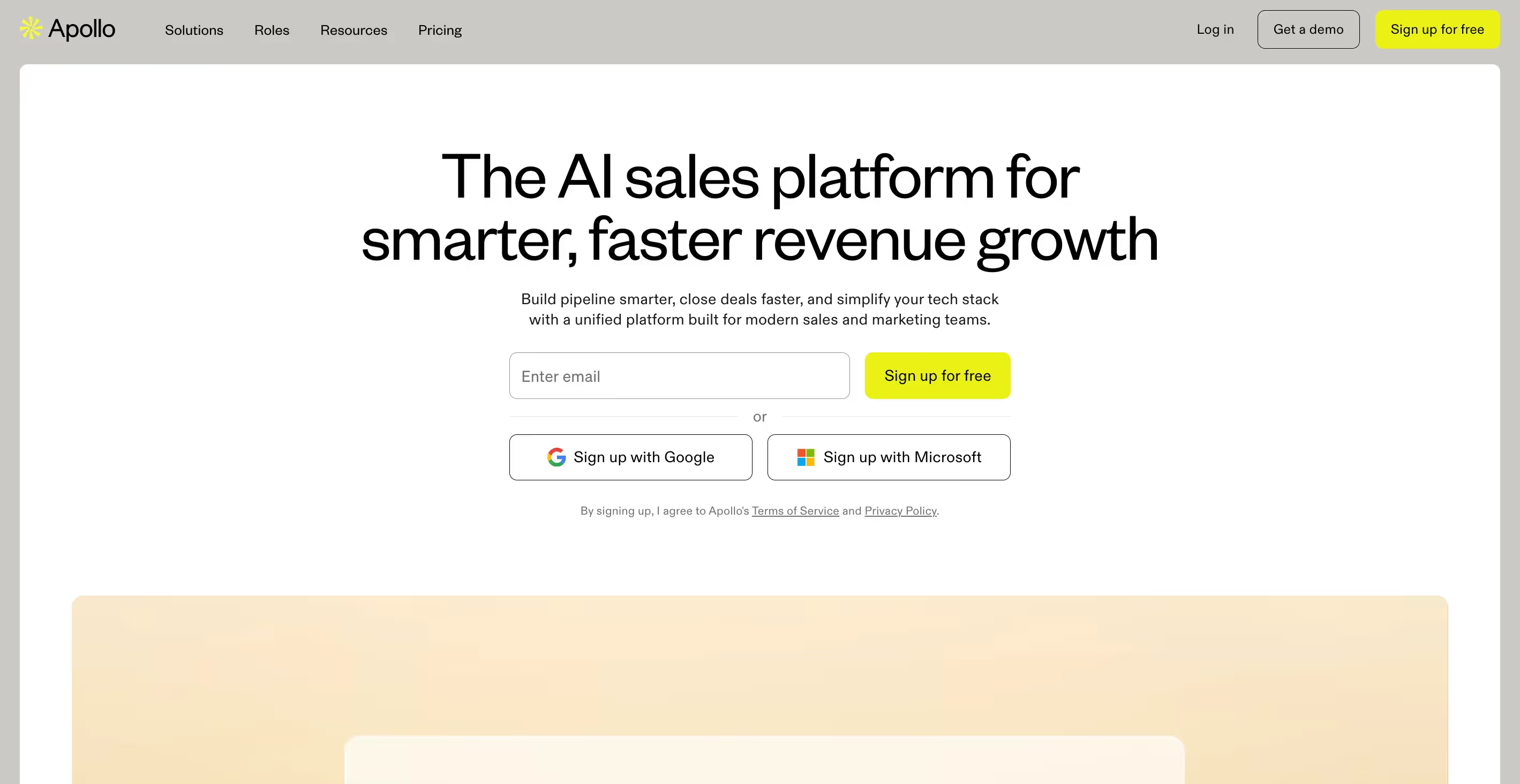
Best for: Scaling teams that need a large verified database with integrated outbound execution.
Apollo.io blends a 275‑million‑contact database with machine‑learning‑based lead scoring and engagement tools. Its AI engine ranks prospects by fit, activity, and intent, then automatically prioritizes outreach sequences through built‑in workflows. Users can trigger actions such as “add to sequence” directly from the platform, linking enriched data to engagement.
AI recommendations identify new target segments by analyzing existing closed‑won accounts. Native integrations with Salesforce, HubSpot, and LinkedIn streamline data sync across systems. Plans start at $49 per user monthly and scale up for enterprise automation and analytics.
Best for: Scaling teams that need a large verified database with integrated outbound execution.
3. ZoomInfo

ZoomInfo has evolved into a full AI sales intelligence platform. It combines broad coverage with predictive analytics that monitor buyer behavior. Its AI models recognize intent signals, such as research trends and website visits, and flag which accounts are warming up. Integrated dashboards map deals, territories, and conversion probability, helping RevOps plan the pipeline with confidence.
Best for: Enterprise organizations seeking predictive intelligence and deep market context.
4. Clay

Best for: GTM teams seeking customizable enrichment workflows powered by AI research automations.
Clay functions as a programmable enrichment assistant. Users define workflows, such as researching company updates, identifying competitors, or finding new contact records, and Clay’s AI executes them automatically. Its models interpret prompts like “find recent press releases about this prospect” to deliver up‑to‑date insights. Integration with Slack and HubSpot means enriched data syncs instantly to the right teams. With flexible pricing from $149 per month, Clay suits GTM builders who prefer agile, configurable tools over static databases.
Best for: GTM teams seeking customizable enrichment workflows powered by AI research automations.
5. LinkedIn Sales Navigator

Sales Navigator uses LinkedIn’s network data to help reps identify and track decision‑makers. Its AI suggests new contacts based on ICP similarity and activity patterns, while real‑time alerts surface job changes or company mentions. CRM sync ensures contact information remains accurate and current. For large organizations, Team and Enterprise tiers add admin control and performance analytics.
AI Outreach & Engagement Automation
Outreach is where pipeline momentum starts. Pre‑AI automation tools handled scheduling and templated sends, but they couldn’t learn, adapt, or personalize beyond preset rules. AI changes it: it analyzes prospect behavior, identifies buying intent, and creates dynamic messaging that feels individual at scale.
AI now determines the optimal time and channel to reach each lead, writes and rewrites copy based on the performance data, and automatically routes warm responses to the right rep. The result is outreach that runs continuously, feels human, and converts faster with minimal manual work.
6. 11x (Alice)

Alice functions as an AI SDR that turns market activity into qualified meetings. She continuously monitors prospects across your target market, identifies intent signals, and runs targeted outreach across email and LinkedIn. Alice continuously optimizes messaging based on engagement data and re-engages high-intent visitors to keep your pipeline active and growing.
- Richer prospect intelligence: integrates more than 20 premium data providers, real-time intent signals, and live search to surface the right prospects at the right moment.
- Personalization that scales: uses research agents and layered personalization frameworks to adapt messaging by role, product, and market context.
- Reliable omni-channel outreach: incorporates inbox rotation, email warming, and spam protection to maintain consistent deliverability across email, LinkedIn, and other channels.
- Enterprise-ready by design: adheres to SOC 2, GDPR, and CASA Tier 3 standards, with dedicated CSMs, Slack support, and direct CRM integrations.
Best for: Revenue teams looking to scale outbound pipeline without hiring more SDRs.
7. Overloop AI
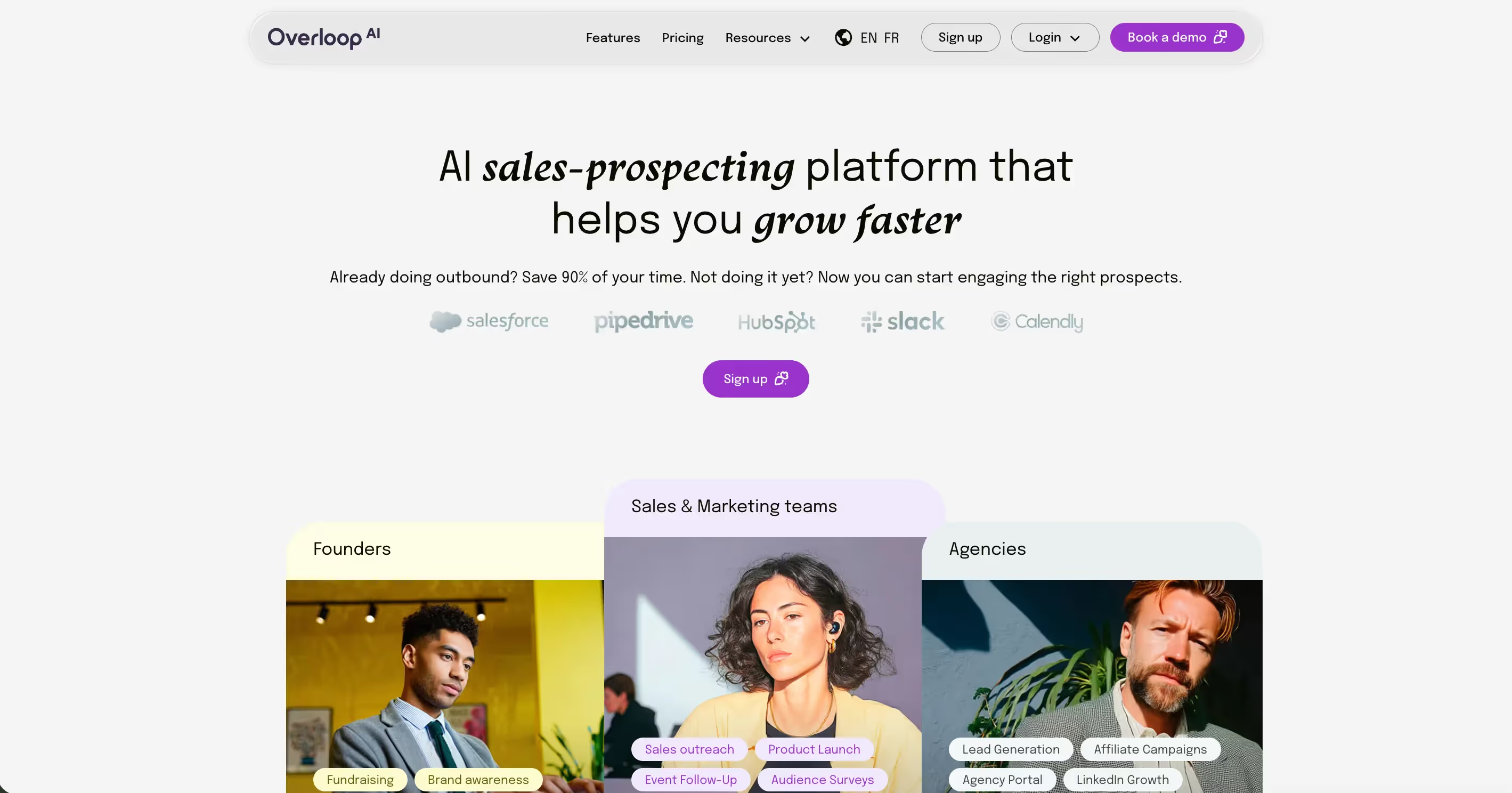
Best for: Teams needing fast, personalized outbound campaigns that still feel authentic.
Overloop uses AI to generate individualized cold emails in seconds, scanning each prospect’s data to tailor tone and value propositions. Its engine tests subject lines, analyzes open and reply rates, and automatically adjusts future sequences. Users can pull contact lists from Overloop’s built‑in database or layer it on top of existing CRM records with automated sync. Campaigns extend across email, LinkedIn, and call follow‑ups, allowing reps to coordinate touchpoints from one interface.
Overloop’s credit‑based pricing model lets companies pay for actual outreach volume rather than user seats, making it scalable from startups to larger outbound teams.
Best for: Teams needing fast, personalized outbound campaigns that still feel authentic.
8. Regie.ai

Regie.ai serves as a complete campaign generation platform. Regie.ai creates and sequences messages across email, LinkedIn, and call scripts that align with company voice and ICP definitions. Managers define frameworks and compliance boundaries, while reps can personalize at the account level through short prompts. It’s particularly effective for RevOps teams looking to keep messaging consistent across global teams without constant manual editing.
Regie’s AI optimization engine studies engagement data and automatically iterates subject lines and copy for improved conversions. Its integrations with Salesforce, HubSpot, and Salesloft mean sequences trigger automatically when new contacts enter the CRM.
Best for: Companies that want an end‑to‑end outbound campaign builder powered by generative content.
9. Outreach

Best for: Enterprise sales teams managing large, multi‑channel cadences and complex deal cycles.
Outreach operates as a comprehensive sales engagement platform. Its AI engine monitors touchpoints across email, voice, social, and chat to identify optimal timing and next steps. During calls, the assistant Kaia detects keywords and surfaces relevant resources or objection-handling responses in real time.
The platform flags at-risk deals by analyzing historical cadence patterns and rep activity levels. It then generates dashboards that translate this data into pipeline visibility for more accurate forecasting. Outreach also automates CRM reporting, ensuring marketing, SDRs, and AEs operate off a single source of truth.
Best for: Enterprise sales teams managing large, multi‑channel cadences and complex deal cycles.
10. Salesloft
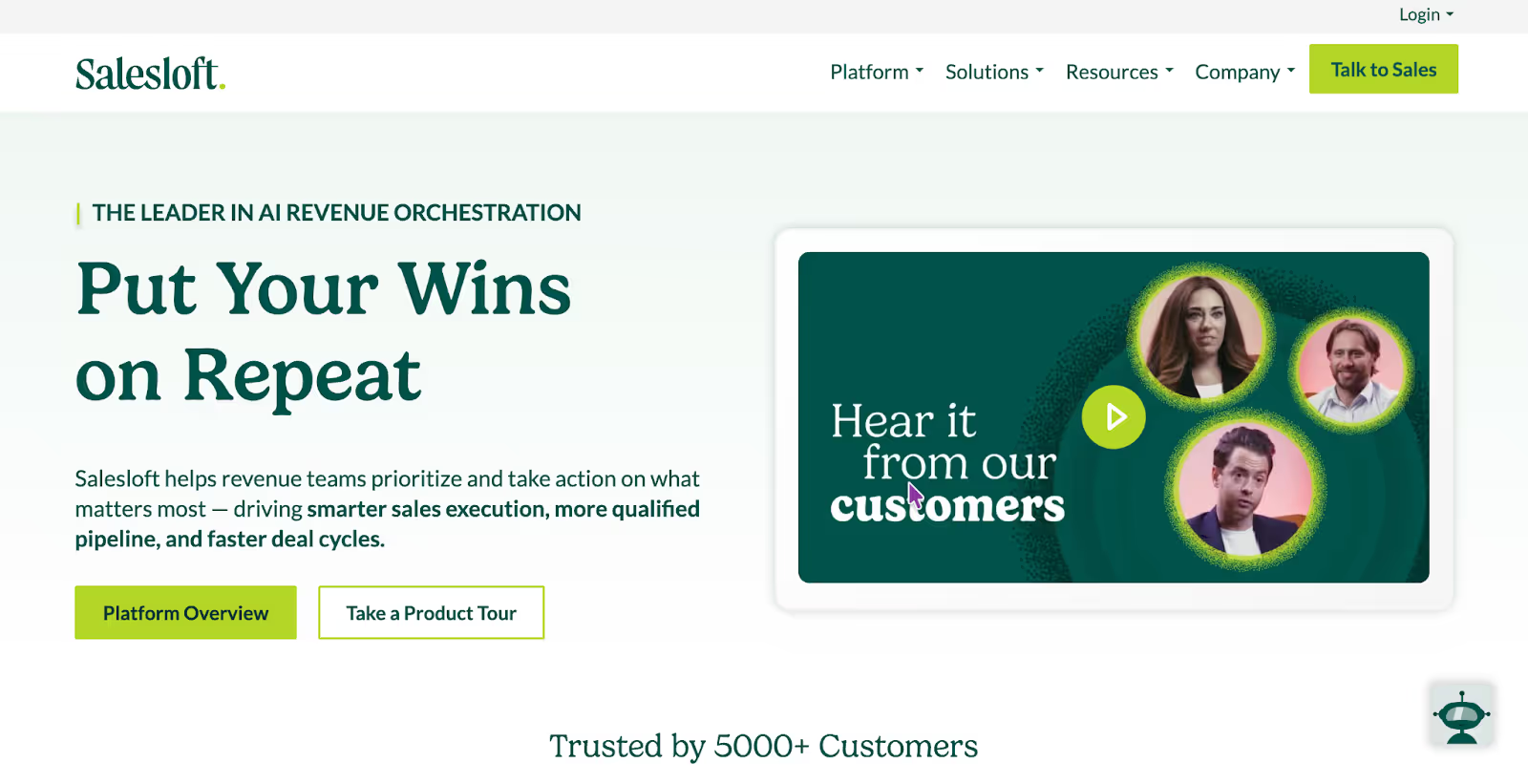
Best for: Mid‑market and enterprise teams seeking AI guidance across prospect prioritization and pipeline management.
Salesloft combines multi-channel outreach with pipeline management in a unified platform. Its AI layer, Conductor, analyzes how prospects engage with messaging, tracks deal velocity, and assesses buyer sentiment to surface which leads need immediate attention.
The platform brings email tracking, call logging, and text engagement into one workspace, so reps don't juggle multiple tools. Managers get activity reports paired with specific coaching recommendations based on what's actually happening in conversations. Integration with Salesforce and LinkedIn keeps activity synced automatically, ensuring data stays accurate across systems.
Best for: Mid‑market and enterprise teams seeking AI guidance across prospect prioritization and pipeline management.
Conversation Intelligence & Coaching
Every sales call is rich with information that can lift team performance. Earlier recorders simply stored call audio, but with artificial intelligence, conversation tools now extract deep insight.
They analyze tone and word choice, track talk‑to‑listen ratios, spot patterns that signal deal risk, and show managers exactly how top performers win. Each conversation becomes structured, measurable data that improves both coaching and forecasting.
11. Gong
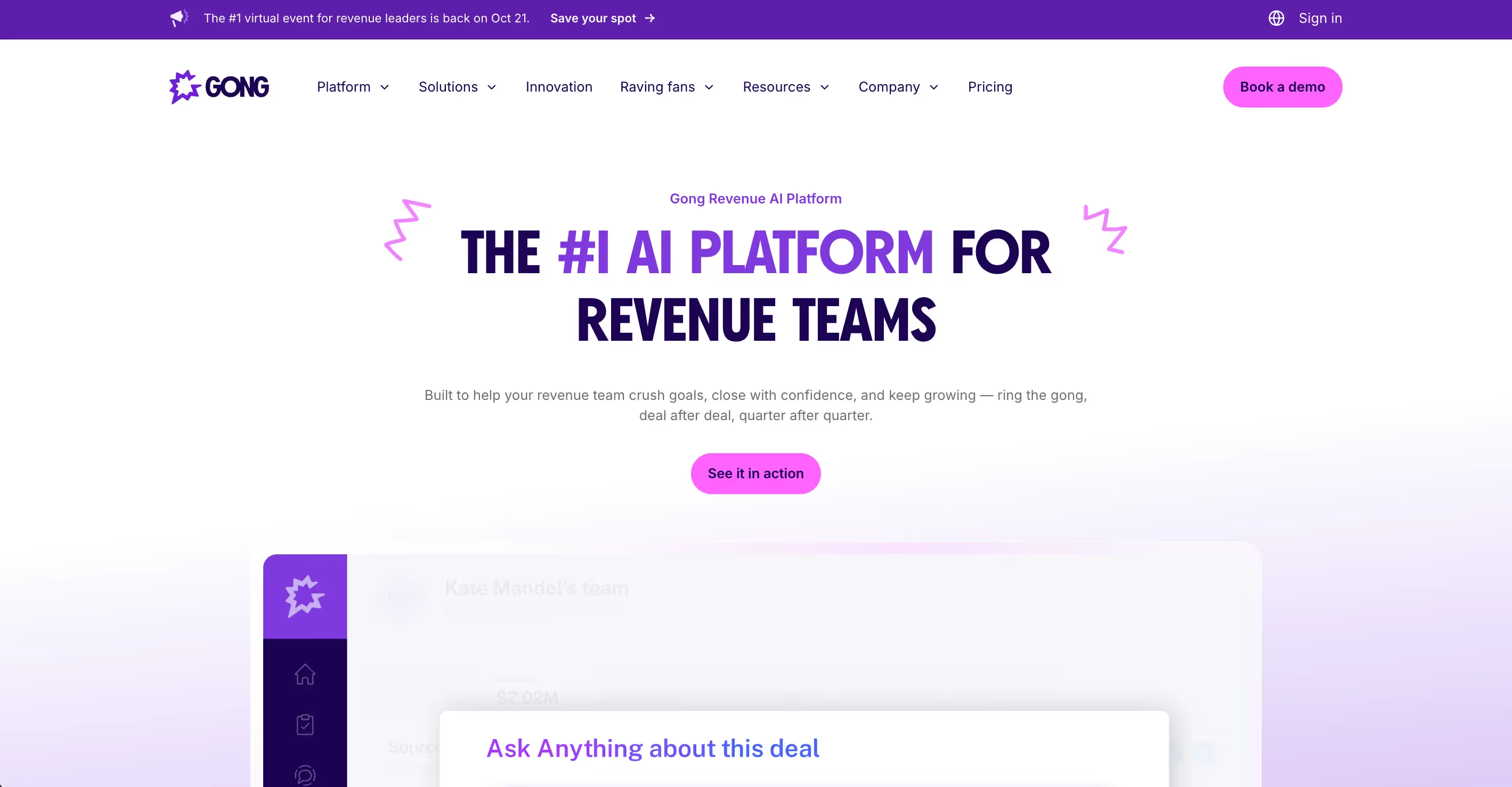
Best for: Large sales organizations that need complete visibility into rep performance and deal health.
Gong captures every customer interaction across calls, meetings, and emails, then uses AI to transcribe and analyze them automatically. It reveals talk ratios, objection patterns, and engagement peaks so managers can see what’s driving positive responses.
Those insights connect directly to CRM data, giving leadership accurate views into pipeline performance and potential risk. Gong also builds a searchable library of real calls that teams use for coaching, onboarding, and sharing best practices.
Best for: Large sales organizations that need complete visibility into rep performance and deal health.
12. Chorus.ai

Best for: Mid‑to‑enterprise teams already using the ZoomInfo ecosystem.
Chorus.ai by Zoominfo records and analyzes conversations from calls and meetings, producing clear transcripts and searchable insights. Its AI highlights critical points such as competitor mentions, pricing discussions, or buying signals.
When paired with ZoomInfo, conversation data is enriched with firmographic and intent layers, giving managers deeper context for deal reviews. Teams rely on Chorus for summarized reports, conversation trends, and call libraries that help standardize coaching across the organization.
Best for: Mid‑to‑enterprise teams already using the ZoomInfo ecosystem.
13. Dialpad

Best for: Teams that need live transcription and coaching during calls.
Dialpad’s built‑in AI assistant provides real‑time responses when key phrases surface, helping reps handle objections or answer complex questions on the spot. It generates accurate transcripts and concise summaries after every call, then pushes follow‑up actions into CRM automatically.
Over time, its machine learning engine identifies keywords, topics, and behaviors linked to higher close rates. Managers gain clear visibility into rep performance and call activity through interactive dashboards. Pricing starts at $49 per user per month, making it accessible for growing teams.
Best for: Teams that need live transcription and coaching during calls.
14. Empower by Ringover

Best for: Mid‑sized teams that want sentiment analysis and call scoring without complex setup.
Empower interprets tone, pacing, and language to gauge how prospects respond throughout a call. Each conversation receives an overall score based on engagement quality and playbook adherence. Managers can review transcripts, bookmark examples of strong interactions, and compile libraries for training.
The platform also aggregates behavioral trends, showing which speech patterns or responses lead to more positive outcomes. Its focus on usability makes it easy for teams to adopt and integrate into their everyday workflow.
Best for: Mid‑sized teams that want sentiment analysis and call scoring without complex setup.
15. Avoma

Best for: Managing the full meeting lifecycle from preparation to post‑call analysis.
Avoma simplifies every part of a meeting. Before a call, it auto‑generates an agenda based on prior communication and meeting context. During the conversation, it captures live transcription and marks key takeaways in real time.
Afterward, Avoma summarizes next steps, identifies discussion themes, and syncs outcomes directly to HubSpot or Salesforce. AI analytics help managers understand how rep interactions influence deal success, supporting data‑driven coaching. It integrates with all major conferencing tools and starts at $29 per user per month.
Best for: Managing the full meeting lifecycle from preparation to post‑call analysis.
16. Lavender

Best for: Reps who want real-time feedback to refine email quality and boost reply rates.
Lavender works as a browser extension that integrates directly into email clients like Gmail and Outlook, as well as sales platforms including Apollo, Gong, and Salesloft. It evaluates each email draft against metrics linked to higher response rates—clarity, length, tone, and personalization depth—then assigns a dynamic score as you write.
Its AI draws on millions of real emails and their reply rates to suggest edits that improve response probability. It also pulls context from a prospect's LinkedIn profile or website to recommend relevant icebreakers and phrasing adjustments. Performance dashboards let managers monitor writing quality across the team and spot patterns in what's working.
Best for: Reps who want real-time feedback to refine email quality and boost reply rates.
Meeting Productivity & Workflow Automation
AI meeting assistants have become the unseen engine that keeps modern sales operations running smoothly. Older transcription tools captured notes but left reps to manage summaries, follow‑ups, and CRM updates manually. With artificial intelligence embedded throughout the process, meeting productivity platforms now prepare agendas, transcribe discussions, identify action items, and sync data automatically.
By eliminating administrative work, these tools create a consistent record of every conversation while keeping the pipeline updated in real time. Reps finish meetings with clear next steps, and leaders gain accurate input for forecasting and performance tracking.
17. Fireflies.ai
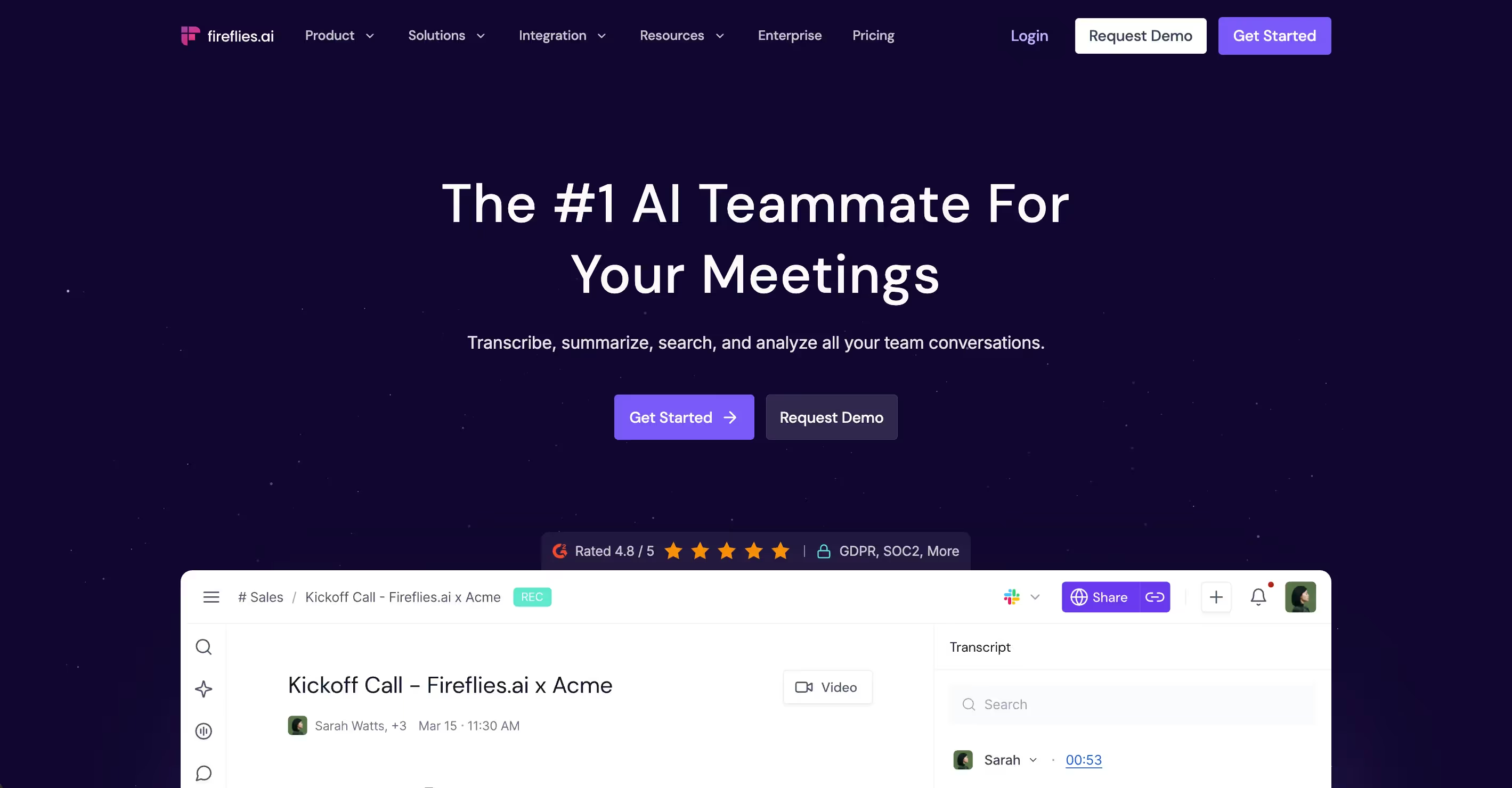
Best for: Teams that need complete recording and summarization across multiple conferencing platforms.
Fireflies attends meetings on Zoom, Microsoft Teams, and Google Meet, capturing every word through accurate AI transcription. After the call, it generates structured summaries, lists key topics, and highlights follow‑up tasks. Notes sync instantly with CRMs such as Salesforce and HubSpot, eliminating manual entry.
The searchable conversation database allows reps to revisit past calls for context or hand them off between team members without losing information. Fireflies offers a free tier for basic use and enterprise upgrades for extended storage, collaboration, and analytics features.
Best for: Teams that need complete recording and summarization across multiple conferencing platforms.
18. Fathom
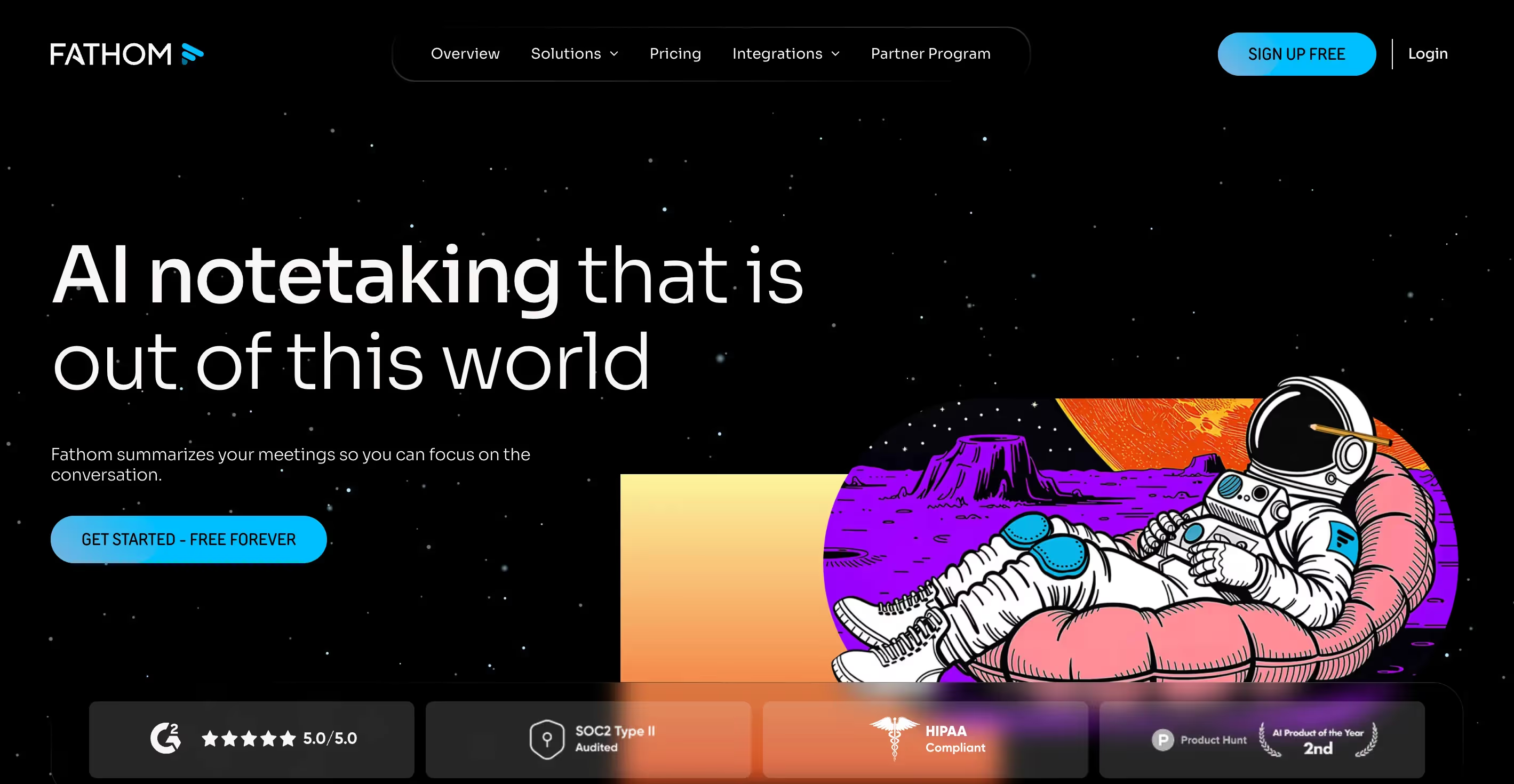
Best for: Reps who want lightning‑fast access to meeting notes and highlights during live calls.
Fathom focuses on speed and clarity. It listens to virtual meetings, produces live highlights, and organizes them into concise summaries that appear within minutes of call completion. The AI identifies key discussion points and sends a ready‑to‑use recap to CRM automatically. This allows reps to move on to their next call without pausing for admin work. Integration with Zoom and HubSpot ensures that meeting data is always captured accurately and visible to managers monitoring deal progression.
Best for: Reps who want lightning‑fast access to meeting notes and highlights during live calls.
19. Cirrus Insight Meeting AI

Best for: Sales professionals who need intelligent pre‑meeting preparation alongside post‑call automation.
Cirrus Insight’s Meeting AI differentiates itself by handling preparation as well as follow‑up. Before a call, it compiles context about the contact or account so reps come in informed and ready to add value. During the meeting, it records and analyzes conversation themes, then produces summaries and suggested follow‑up actions.
Post‑call, those insights flow directly into CRM, creating a continuous record of engagement. This end‑to‑end automation reduces research time and helps every meeting connect more strategically to pipeline goals.
Best for: Sales professionals who need intelligent pre‑meeting preparation alongside post‑call automation.
20. Otter.ai (OtterPilot)
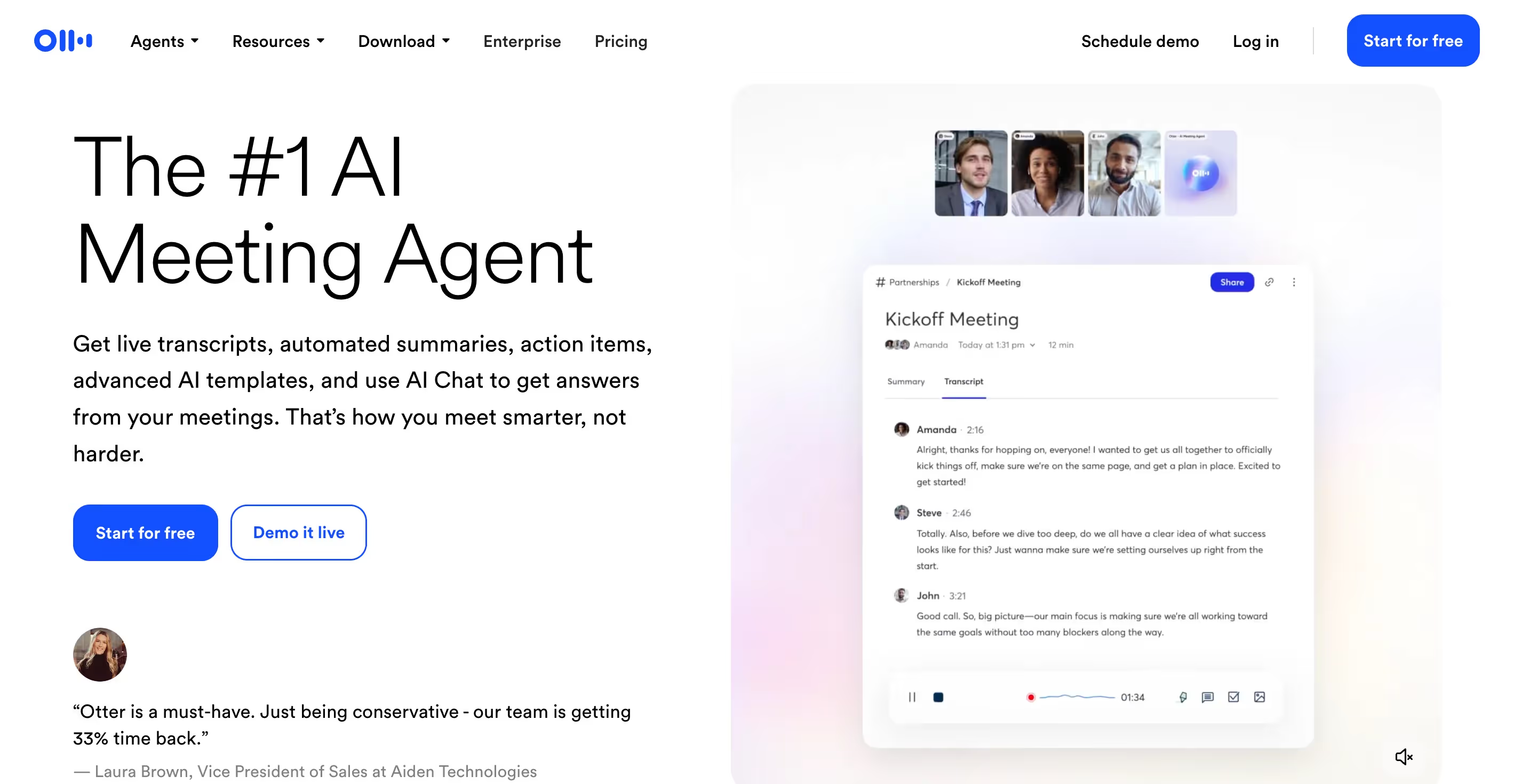
Best for: Teams that want simple, reliable transcription and sharing at a low cost.
Otter’s OtterPilot automatically records and transcribes virtual meetings, then creates a searchable transcript accessible through Slack, HubSpot, or export links. The AI highlights key moments such as decisions or action items so users can find them instantly rather than listening to full recordings. Summaries are generated in plain language, making them suitable for internal updates or client handoffs.
Otter’s intuitive setup makes it a quick win for teams that want consistent note‑taking without complex deployment. Paid plans start at $10 per month, with enterprise options for larger teams requiring higher security and data retention.
Best for: Teams that want simple, reliable transcription and sharing at a low cost.
Revenue Forecasting & Pipeline Management
Accurate forecasting is the backbone of effective revenue planning. Traditional projections often rely on rep input and intuition, leading to inconsistent outcomes. With AI in the loop, forecasting tools now analyze hundreds of variables to predict results with far greater precision.
AI-powered platforms automatically capture activity data, evaluate deal health, and flag risks before opportunities stall. By connecting enrichment, outreach, and meeting insights into a single model, they show which accounts are most likely to convert—and when. This unified, data-driven visibility empowers leaders to prioritize efforts, manage risk, and plan revenue strategies with confidence.
21. Clari
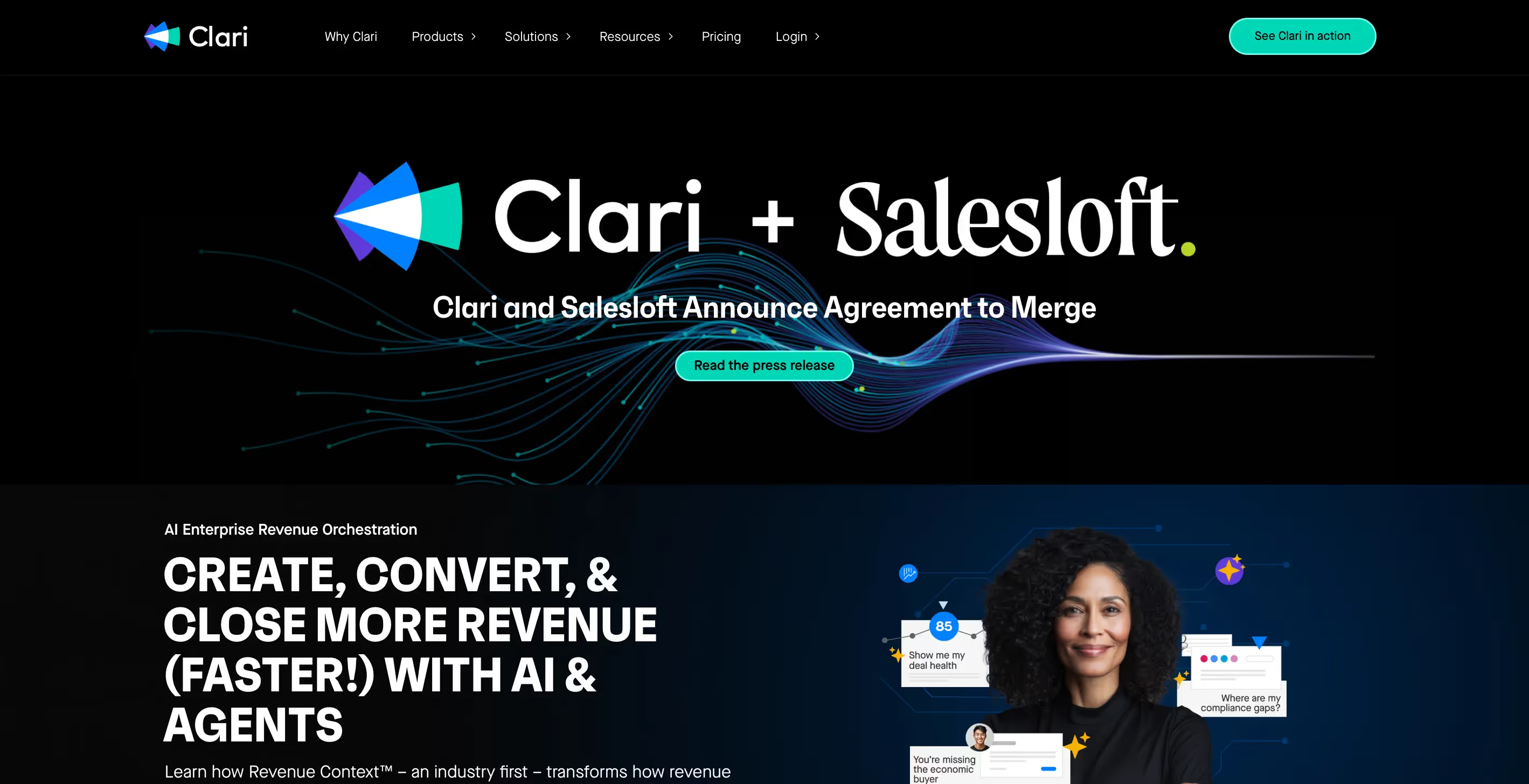
Best for: Revenue teams that want real‑time visibility and predictive forecasting accuracy.
Clari captures all activity and translates it into real‑time deal health scores. Its AI compares current engagement against past wins to project close probability and alert managers to at‑risk opportunities. Dashboards update continuously, giving RevOps leaders a live view of pipeline changes and forecast accuracy.
Best for: Revenue teams that want real‑time visibility and predictive forecasting accuracy.
22. InsightSquared
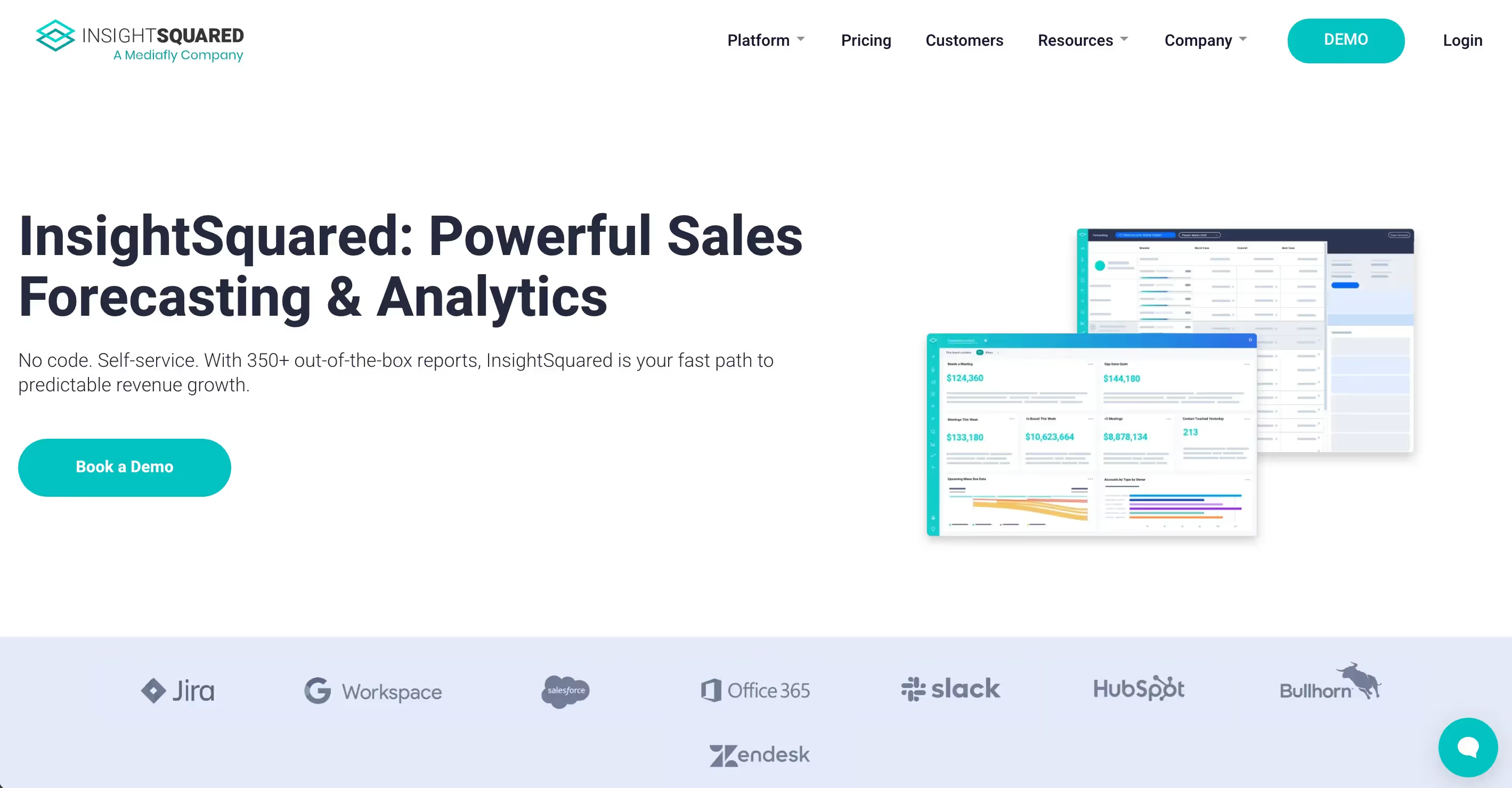
Best for: Data‑driven organizations seeking deep analytics and customizable reporting.
InsightSquared aggregates CRM and sales activity data into hundreds of ready reports on conversion, quota attainment, and pipeline coverage. Its AI detects gaps that weaken forecasts and highlights which campaigns, personas, or territories drive consistent wins. The result is clear, evidence‑based planning that removes guesswork from management decisions.
Best for: Data‑driven organizations seeking deep analytics and customizable reporting.
23. SPOTIO

Best for: Field sales organizations that need mobile visibility, route optimization, and localized forecasting.
SPOTIO uses AI to map activity patterns and predict revenue by location. Reps log visits, notes, and outcomes from mobile devices, while analytics update territory forecasts automatically. Heatmaps reveal high‑potential zones and underperforming areas, helping managers refine rep routes and resource focus.
With forecasting powered by live pipeline data, leadership finally sees a real‑time picture of revenue health. AI replaces manual reporting with predictive insight, turning forecasting from an end‑of‑month exercise into a continuous growth engine.
Best for: Field sales organizations that need mobile visibility, route optimization, and localized forecasting.
Key Factors When Choosing AI Sales Tools
Choosing an AI sales platform is a strategic decision that shapes how your team sells, measures success, and scales future growth. The best tool is not the one with the longest feature list but the one that fits seamlessly into your existing process and delivers measurable revenue impact. Use these criteria to evaluate your options with confidence.
1. Define your primary use case
Clarify where automation will create the most impact. If your challenge is lead generation, prioritize enrichment platforms with verified contact information, intent data, and CRM sync. For pipeline acceleration, look to outreach or conversation intelligence tools that shorten cycle times. If you’re looking for an integrated workflow, you need to evaluate end‑to‑end AI sales tools of capable of handling enrichment, engagement, and reporting in one platform, such as 11x.
2. Understand pricing structures
AI sales tools use a variety of pricing models: per user, per contact, per credit, or tiered by feature access. A platform with a free plan might serve early experimentation, but meaningful results usually require enterprise‑grade data access and customization. Estimate ROI not just by subscription cost but by hours saved, pipeline value created, and redundant software you can retire after adoption.
3. Review integration depth, not just compatibility
Almost every tool connects to Salesforce, HubSpot, Slack, or LinkedIn, but the real question is how deeply the systems exchange data. Check whether updates flow bi‑directionally, whether field‑level mapping is supported, and if workflows trigger automatically. Integrated AI should close the loop between prospecting, engagement, and reporting so teams spend little or no time moving data manually.
4. Measure performance through clear metrics
Establish KPIs before implementation. For outbound teams, track reply rates, meetings booked, and average days to qualified opportunity. For conversation intelligence, measure talk‑to‑listen ratio improvements or shorter follow‑up response times. For forecasting tools, focus on the variance between predicted and actual revenue. AI is valuable when it produces repeatable, measurable lift, not when it merely automates existing inefficiencies.
5. Verify data security and compliance.
Sales data often includes sensitive customer and contact information. Confirm the vendor’s compliance with SOC 2 Type II, GDPR, and CCPA standards, and ask where data is stored and processed. Enterprise buyers should also review encryption policies and role‑based access controls. AI systems that integrate directly into your CRM must protect first‑party data with the same rigor as your core infrastructure.
Thoughtful evaluation across these areas ensures your AI investments actually strengthen pipeline performance instead of adding another layer of tools to manage.
The Future Sales Stack Is Powered by AI
Artificial intelligence is now the operating layer of modern sales—automating enrichment, outreach, and forecasting so teams can focus on closing, not clicking.
11x is the advanced GTM platform built for this new era. Instead of relying on fragmented point solutions, 11x unifies prospecting, enrichment, warmup, and engagement into a single intelligent system that drives consistent revenue execution.
Alice, our AI SDR, runs multi-channel outbound on autopilot—identifying prospects, crafting personalized sequences, and scaling outreach to thousands of leads each day. Julian, our AI phone agent, instantly qualifies inbound leads, manages follow-ups, and reactivates stalled opportunities to keep the pipeline moving.
Together, they power a connected GTM engine that continuously finds, nurtures, and converts leads—without the manual effort.
See how 11x can power your revenue engine—book your demo today.
Frequently Asked Questions
AI sales tools are focused utilities that handle specific jobs such as enriching contact information, automating outreach sequences, or providing sales forecasts. AI assistants go further by running workflows end to end. With artificial intelligence at their core, they qualify leads, track every engagement, and execute tasks across channels without supervision. Alice and Julian are examples of AI assistants that act as digital teammates, not point solutions.
Artificial intelligence helps take manual steps off a rep’s plate, not mimic every part of the role. These systems qualify inbound leads, enrich records with fresh contact information, and send follow‑up sequences at scale. Reps are still needed to negotiate, manage complex relationships, and close deals. Teams that use AI see fewer dropped opportunities and faster cycles because human sellers can focus only on high‑value interactions.
Salesforce, HubSpot, and LinkedIn are the most common integration hubs. AI tools can enrich records with updated contact information, run AI-powered outreach messages, and push summaries automatically into these systems. The best platforms use AI to sync data across the stack in real time, so leadership always has accurate pipeline visibility.
When teams use AI efficiently, every stage of the sales funnel benefits. Enrichment tools keep contact information accurate, outreach platforms generate personalized emails, and call intelligence tools capture insights that improve coaching. The result is more qualified conversations, higher reply rates, and cleaner forecasting models.


.png)
.png)
.png)
.png)
.png)
